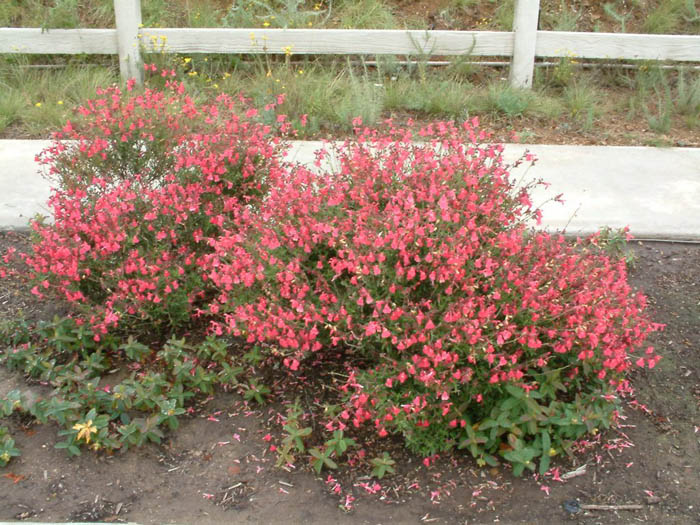Salvia greggii
Autumn or Texas Sage

Description
The Autumn Sage is a hybrid evergreen shrub that grows 2'-3' high It has fragrant green leaves and colorful flowers in shades of red that bloom in spring and summer. This lovely perennial can tolerate sun or partial shade and is hardy to 15 degrees. The Autumn Sage is drought tolerant and attracts hummingbirds. The flower colors that can be grown are: Coral, Pink, Purple, Red, and White. It can be grown near the coast and in inland warm valleys.
Maintenance Tips
Salvia greggii, also known as Autumn Sage, is one of the best woody shrubs for attracting birds, especially hummingbirds. The shrub typically grows 2-3' tall and wide with the flower stalks reaching another 6" beyond the foliage. There are many hybrids of this species with different flower colors, flower sizes, and overall size at maturity. They are all woody shrubs that tend to become dense with cross branching, so thinning out the branches and allowing sunlight to the interior benefits the plant greatly. All of the flowers are born at the tips of the branches so hedging is discouraged as it will cut off the blooming potential.
Plant Type
Shrub
Height Range
1-3'
Flower Color
Lavender, Pink, Purple, Red, White
Flower Season
Spring, Summer
Leaf Color
Green
Bark Color
n/a
Fruit Color
n/a
Fruit Season
n/a
Sun
Full, Half
Water
Very Low, Extra in Summer
Growth Rate
Moderate
Soil Type
Sandy, Loam, Rocky
Soil Condition
Average, Poor, Well-drained
Soil pH
Neutral, Basic
Adverse Factors
n/a
Design Styles
Mediterranean, Seascape, Spanish
Accenting Features
Fragrance, Showy Flowers
Seasonal Interest
Winter, Spring, Summer, Fall
Location Uses
Entry, Parking Strip, Patio, Park, Raised Planter, Swimming Pool, Walkways, With Rocks
Special Uses
Filler, Mass Planting, Naturalizing, Small Spaces
Attracts Wildlife
Hummingbirds
Water Saving Tip:
Weather changes - so should your watering schedule. Be sure to make seasonal watering adjustments at a minimum.